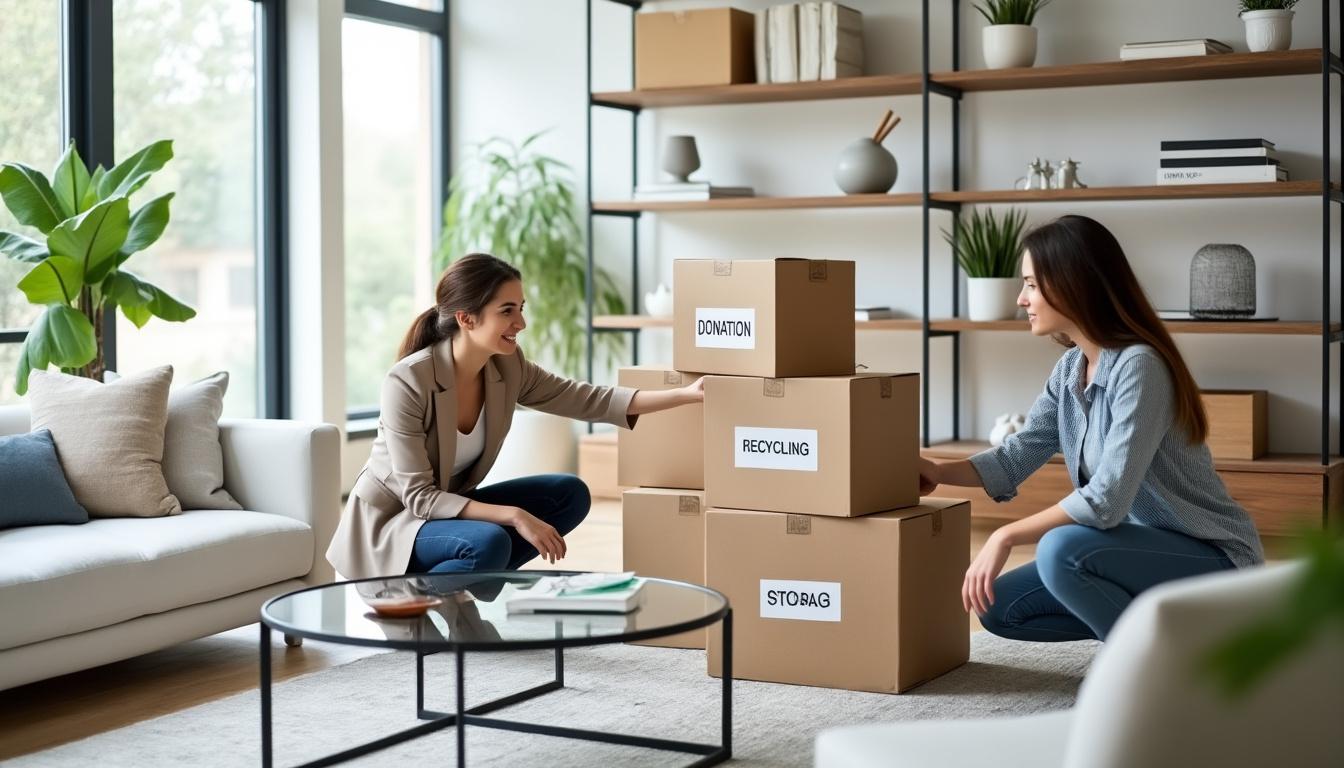Downsizing a living space presents a unique mix of logistical challenges and emotional hurdles, especially as a growing number of individuals seek to adapt their lifestyles to smaller, more manageable homes. This shift, often termed the “silver tsunami,” reflects a demographic wave of older homeowners opting for cozier, less cluttered environments. The intricate dance of streamlining possessions while honoring memories and habits demands savvy strategies, many refined by professional organizers who specialize in easing these transitions. Within the realm of organizing and decluttering, authorities such as Marie Kondo, FlyLady, and The Container Store have popularized approaches that simplify decision-making and restore harmony to daily living spaces. For those embarking on this journey, embracing practical methods from recognized organizers like the Neat Method or Hocus Focus can transform downsizing into an empowering, balanced experience.
Strategic Prioritization: Identifying What Truly Matters When Downsizing
The cornerstone of successful downsizing lies in discerning which possessions warrant preservation and which can be thoughtfully released. A professional organizer’s approach begins not with what to discard but with identifying items essential to one’s lifestyle and well-being. This strategic prioritization transforms the process from an overwhelming purge into constructive organization.
Starting with a catalog of indispensable belongings helps build momentum. Rather than fixating on clutter, individuals are encouraged to create a positive inventory—things that genuinely add value to everyday life. For example, sentimental items that spark joy as per Marie Kondo’s philosophy can be grouped separately, ensuring emotional needs are honored but not at the overwhelming expense of space.
Organized Living systems often recommend splitting possessions into categories like essentials, sentimental keepsakes, and non-essential items. This segmentation enables targeted decisions that respect emotional connections while promoting practical constraints. To illustrate, consider a kitchen where redundant utensils, multiple coffee makers, or an excess of dishware are evaluated with intention: Simplify by keeping a modest number of quality pieces rather than a collection that only accumulates dust.
- Make a list of must-have items prior to sorting.
- Separate belongings by categories based on frequency of use and emotional value.
- Apply a one-in, one-out rule to maintain manageable quantities.
- Focus initial energy on rooms used most frequently, such as kitchens and bedrooms.
| Category | Examples | Downsizing Strategy |
|---|---|---|
| Essentials | Daily cookware, favorite books, everyday clothing | Keep items in active rotation; replace duplicates with multifunctional tools |
| Sentimental | Photographs, heirlooms, memorabilia | Preserve selectively; consider digitizing or temporary storage |
| Non-Essentials | Unused gadgets, duplicates, outdated decor | Donate, sell, or recycle responsibly; avoid clutter carryover |
Employing tools from Get Organized or ClutterBug can facilitate maintaining discipline during sorting phases. These methods naturally integrate visual cues and breaking tasks into manageable chunks, perfect for reducing decision fatigue and making downsizing streamlined.
Emotional Resilience: Handling Sentimental Attachments During Downsizing
Downsizing extends beyond the physical realm; the emotional impact can be profound, particularly for individuals managing loss, breakup, or major life transitions. Emotional attachments to belongings, often deeply intertwined with memories and identity, require sensitive navigation.
Professional organizers like those from Neat Method emphasize the importance of allowing space for these feelings. Confronting the emotional weight of memorabilia rather than suppressing it prevents paralysis in decision-making. Recognizing emotions as valid rather than inconvenient makes the process gentler and more sustainable.
Examples include clients who face extensive collections of a deceased loved one’s belongings. Tackling such volume using methods like those advocated by Marie Kondo involves asking whether these possessions contribute to happiness or serve as daily reminders of grief. If the latter, donation, selling, or storing items for future appraisal offers relief.
- Create a timeline for subjective decisions to avoid rushed emotions.
- Separate emotionally charged items from everyday possessions.
- Consider digitizing photos and documents to conserve memory with minimal space.
- Enlist social support or professional guidance to share the emotional load.
| Emotional Challenge | Recommended Strategy | Outcome |
|---|---|---|
| Loss of a loved one | Temporary storage units for memorabilia; phased decision-making | Reduced grief triggers; time to emotionally adjust |
| Sentimental clutter | Digitization and selective retention | Preservation of memories without physical burden |
| Emotional decision fatigue | Professional organizer support; break tasks into manageable steps | Improved decision capacity and emotional balance |
Such approaches ensure that downsizing is not perceived solely as loss but also as an optimistic opportunity to “Simplify” one’s living environment and start anew. This mindset shift, celebrated within Organizing expert communities like FlyLady, helps to transform the downsizing journey into a milestone of personal growth.
Optimizing Space Utilization: Decluttering Key Areas for Effective Downsizing
Maximizing space efficiency, particularly in kitchens, garages, and closets, is a pivotal focus for those adapting to smaller homes. Industry leaders stress that these “big three” areas often contain the majority of underutilized or redundant items.
A kitchen, for example, rarely requires an extensive collection of dishes or appliances. Streamlining to essential sets—perhaps six to eight place settings instead of sixteen—grants more room for function and flow. Appliances can be consolidated where possible; choosing compact, multipurpose devices aligns with efficient living advocated by The Container Store’s best practices for space-saving solutions.
Closet downsizing benefits from controlled inventory, emphasizing wardrobe rotation and seasonal curation. Techniques inspired by ClutterBug’s organizing methodology suggest using color-coding and clear storage bins to enhance visibility and access.
The garage, often a storage catch-all, poses a daunting challenge particularly for renters or those moving to units without additional storage space. Assessments guided by the “Sort and Succeed” strategy recommend upfront decisions on keeping versus releasing rarely used tools, outdoor gear, or old renovation materials.
- Implement a room-by-room review using checklists designed by Hocus Focus methodologies.
- Replace bulky single-use items with multifunctional alternatives.
- Store seasonal items off-site or in compact storage containers.
- Donate or sell tools and equipment that haven’t been utilized in over a year.
| Area | Common Challenges | Space-Saving Solutions |
|---|---|---|
| Kitchen | Excess dinnerware, multiple appliances | Minimalist sets, compact versatile appliances |
| Closets | Overstocked clothing, poor visibility | Seasonal rotation, storage bins with labels |
| Garage | Accumulated tools, bulky outdoor gear | Donate/sell unused items, off-site storage |
Incorporating tutorials from platforms like Organized Living and FlyLady can empower individuals to maintain clutter-free zones well beyond their initial downsizing move. Aligning space optimization with lifestyle needs results in sustainable home management, with less stress and more functionality.
Adapting Consumption Habits and Embracing Lifestyle Simplification
Reducing physical possessions goes hand in hand with rethinking consumption patterns. Downsizing invites a fundamental shift: moving away from stockpiling toward mindful acquisition and living “in the moment.” This change is critical when pantry and storage space diminish.
A professional organizer’s insights reveal that clients often struggle to adjust their traditional habits, such as buying bulk goods at Costco for what’s termed “backstock.” Downsizers must recalibrate expectations, purchasing only what’s necessary to fit within their scaled-down environment without creating clutter.
Strategies from experts allied with The Container Store and Simplify encourage implementing inventory checks and regular purges aligned with planned purchases. These steps reduce waste and ease mental load on managing goods.
- Create a shopping list based on current needs rather than past habits.
- Maintain a small, well-curated pantry with essentials only.
- Plan weekly meal preparations to avoid excess food purchases.
- Use smart storage solutions such as stackable containers and modular shelving.
| Habit | Common Issue | Downsizing Solution |
|---|---|---|
| Bulk buying | Excess inventory taking up limited pantry space | Buy in smaller quantities; schedule regular shopping trips |
| Hoarding essentials | Backstock clutter | Maintain only immediate-use supplies |
| Impulse buying | Accumulated unnecessary items | Implement list-based shopping and budgeting |
Combining these changes with techniques from FlyLady’s rhythm-oriented cleaning routines or Marie Kondo’s decluttering ethos helps sustain a new lifestyle of simplicity and responsiveness. This results in a more organized, peaceful home environment perfectly tailored to one’s present stage of life.
Effective Use Of Temporary Storage And Fresh-Start Mindset In Downsizing
Facing a tight timeline or emotionally taxing decisions, some individuals find temporary storage units offer a practical buffer, allowing for thoughtful downsizing at a manageable pace. Professional organizers advise this approach as a “Band-Aid” to alleviate immediate pressures without compromising the overall downsizing goal.
Using storage units to stow away deeply sentimental or complex-to-decide belongings not only temporizes tough choices but also prevents hasty disposal of treasures. Items such as archival photographs, personal correspondence, or favorite collectibles can be held in trust as the downsizer acclimates to their smaller space.
Equally essential is embracing a fresh-start mentality. For many, downsizing represents a chance to rebuild a home with only quality essentials and modern, space-efficient items. This perspective is reinforced by advocates like Marie Kondo and the Neat Method who promote not only decluttering but intentional renewal. Investing in new appliances or furnishings that match the smaller dimensions is often a worthwhile consideration.
- Rent temporary storage for emotional or bulky items.
- Create a timeline for revisiting stored possessions.
- Consider replacing heavy or outdated equipment with slim, efficient alternatives.
- Budget for new purchases that fit new space and lifestyle needs.
| Scenario | Benefit of Temporary Storage | Mindset Shift |
|---|---|---|
| Short-term housing deadline | Flexibility to sort items without rush | View downsizing as an opportunity for renewal |
| Emotional difficulty with certain belongings | Preservation without immediate decision | Embrace a minimalist lifestyle that favors essentials |
| Budget constraints for new purchases | Gradual investment in essentials | Focus on quality over quantity |
For readers interested in detailed strategies about managing housing costs and children during such transitions, valuable insights are available through this guide on saving house rent while managing kids. Utilizing these combined strategies from expert organizers transforms downsizing from a source of stress into a carefully orchestrated process of renewal and simplification.
Frequently Asked Questions About Downsizing and Professional Organizing
- How can I handle sentimental items without feeling overwhelmed?
Separating them into categories and considering digitization of photos or documents helps preserve memories while easing physical space. Additionally, temporary storage can provide time to emotionally adjust before making final decisions. - What are the best rooms to focus on first when downsizing?
Prioritize the kitchen, garage, and closets as these areas tend to accumulate the most excess and often impact daily life the most. - Is it advisable to buy new items when downsizing?
Yes, purchasing smaller, multifunctional, and matching items can simplify living and reduce clutter in a smaller space. - How do professional organizers help reduce downsizing stress?
They provide emotional support, create structured plans, and introduce proven systems like FlyLady or ClutterBug to help maintain momentum and clarity. - Can temporary storage be a useful tool during downsizing?
Absolutely. It offers flexibility and emotional space for difficult decisions but should be used thoughtfully to avoid indefinite storage of unnecessary items.

